TheUMAPJournal
Publisher
COMAP, Inc.
Vol. 27, No. 2
校
苑
数
模
.
w
w
w
m
a
t
h
o
r
.
c
o
m
Executive Publisher
Solomon A. Garfunkel
ILAP Editor
Chris Arney
Associate Director,
Mathematics Division
Program Manager,
Cooperative Systems
Army Research Office
P.O. Box 12211
Research Triangle Park,
NC 27709-2211
David.Arney1@arl.army.mil
On Jargon Editor
Yves Nievergelt
Department of Mathematics
Eastern Washington University
Cheney, WA 99004
ynievergelt@ewu.edu
Reviews Editor
James M. Cargal
Mathematics Dept.
Troy University—
Montgomery Campus
231 Montgomery St.
Montgomery, AL 36104
jmcargal@sprintmail.com
Chief Operating Officer
Laurie W. Arag´on
Production Manager
George W. Ward
Production Editor
Timothy McLean
Distribution
Kevin Darcy
John Tomicek
Graphic Designer
Daiva Kiliulis
Editor
Paul J. Campbell
Campus Box 194
Beloit College
700 College St.
Beloit, WI 53511–5595
campbell@beloit.edu
Associate Editors
Don Adolphson
Chris Arney
Aaron Archer
Ron Barnes
Arthur Benjamin
Robert Bosch
James M. Cargal
Murray K. Clayton
Lisette De Pillis
James P. Fink
Solomon A. Garfunkel
William B. Gearhart
William C. Giauque
Richard Haberman
Jon Jacobsen
Walter Meyer
Yves Nievergelt
Michael O’Leary
Catherine A. Roberts
John S. Robertson
Philip D. Straffin
J.T. Sutcliffe
Brigham Young University
Army Research Office
AT&T Shannon Research Laboratory
University of Houston—Downtown
Harvey Mudd College
Oberlin College
Troy University— Montgomery Campus
University of Wisconsin—Madison
Harvey Mudd College
Gettysburg College
COMAP, Inc.
California State University, Fullerton
Brigham Young University
Southern Methodist University
Harvey Mudd College
Adelphi University
Eastern Washington University
Towson University
College of the Holy Cross
Georgia Military College
Beloit College
St. Mark’s School, Dallas
�
Subscription Rates for 2006 Calendar Year: Volume 27
Membership Plus
Individuals subscribe to The UMAP Journal through COMAP’s Membership Plus. This subscription
also includes a CD-ROM of our annual collection UMAP Modules: Tools for Teaching, our
organizational newsletter Consortium, on-line membership that allows members to download and
reproduce COMAP materials, and a 10% discount on all COMAP purchases.
(Domestic)
(Outside U.S.)
#2620
#2621
$104
$117
Institutional Plus Membership
Institutions can subscribe to the Journal through either Institutional Plus Membership, Regular
Institutional Membership, or a Library Subscription. Institutional Plus Members receive two print
copies of each of the quarterly issues of The UMAP Journal, our annual collection UMAP Modules:
Tools for Teaching, our organizational newsletter Consortium, on-line membership that allows
members to download and reproduce COMAP materials, and a 10% discount on all COMAP purchases.
(Domestic)
(Outside U.S.)
#2670
#2671
$479
$503
Institutional Membership
Regular Institutional members receive print copies of The UMAP Journal, our annual collection
UMAP Modules: Tools for Teaching, our organizational newsletter Consortium, and a 10% discount on
all COMAP purchases.
(Domestic)
(Outside U.S.)
#2640
#2641
$208
$231
Web Membership
Web membership does not provide print materials. Web members can download and reproduce
COMAP materials, and receive a 10% discount on all COMAP purchases.
(Domestic)
(Outside U.S.)
#2610
#2610
$41
$41
To order, send a check or money order to COMAP, or call toll-free
1-800-77-COMAP (1-800-772-6627).
The UMAP Journal is published quarterly by the Consortium for Mathematics and Its Applications
(COMAP), Inc., Suite 3B, 175 Middlesex Tpke., Bedford, MA, 01730, in cooperation with the
American Mathematical Association of Two-Year Colleges (AMATYC), the Mathematical
Association of America (MAA), the National Council of Teachers of Mathematics (NCTM), the
American Statistical Association (ASA), the Society for Industrial and Applied Mathematics (SIAM),
and The Institute for Operations Research and the Management Sciences (INFORMS). The Journal
acquaints readers with a wide variety of professional applications of the mathematical sciences and
provides a forum for the discussion of new directions in mathematical education (ISSN 0197-3622).
Periodical rate postage paid at Boston, MA and at additional mailing offices.
Send address changes to: info@comap.com
COMAP, Inc., Suite 3B, 175 Middlesex Tpke., Bedford, MA, 01730
© Copyright 2006 by COMAP, Inc. All rights reserved.
�
Vol. 27, No. 2 2006
Table of Contents
Editorial
HIV: The Math
Paul J. Campbell . . . . . . . . . . . . . . . . . . . . . . .
. . . . . . . . . . . . . . . . 93
Special Section on the ICM
Results of the 2006 Interdisciplinary Contest in Modeling
Chris Arney . . . . . . . . . . . . . . . . . . . . . . . . . . . . . . . . . . . . . . . . . . 95
The United Nations and the Quest for the Holy Grail (of AIDS)
Andrew Mehta, Quianwei Li, and Aaron Wise . . . . . . . . . . . . . . . . . . . 113
Managing the HIV/AIDS Pandemic: 2006–2055
Tyler Huffman, Barry Wright III, and Charles Staats III . . . . . . . .129
AIDS: Modeling a Global Crisis (and Australia)
Chris Cecka, Michael Martin, and Tristan Sharp . . . . . . . . . . . . . . 145
The Spreading HIV/AIDS Problem
Adam Seybert, David Ryan, and Nicholas Ross . . . . . . . . . . . . . . 163
Judge's Commentary: The Outstanding HIV/AIDS Papers
Kari Murad and Joseph Myers . . . . . . . . . . . . . . . . . . . . . . . . . . . 175
Author’s Commentary: The Outstanding HIV/AIDS Papers
Heidi Williams . . . . . . . . . . . . . . . . . . . . . . . . . . . . . . . . . . . . . . . . 181
�
�
Editorial
93
Editorial
HIV: The Math
Paul J. Campbell
Mathematics and Computer Science
Beloit College
Beloit, WI 53511
campbell@beloit.edu
Roughly 1% of the world’s adult population is infected with HIV, which
currently results in 2.8 million deaths per year (3% of all deaths and almost
three times as many as malaria).
What can mathematics offer in the struggle against this disease? Mathemat-
ics itself offers no protection and no cures. However, like claims early on that
“everyone” can get AIDS, and revelations of false assurances of safety of the
blood supply in the U.S. and France, mathematics can definitely help add to the
scare effect. Many years ago, I rejected for publication in this Journal a paper by
a student team that projected that most American adults would be infected by
HIV—or dead from it—by now. Both the modeling and the conclusions were
unsound. The dynamic of HIV, however, has since taught us again an old les-
son, that fear is weaker than desire. (This Journal did publish a UMAP Module
on HIV recently [Isihara 2005], dealing mainly with immunological aspects.)
What mathematics can do is project immediate past and current trends, to
reveal what the future could be without basic change. In the case of HIV, the
results are encouraging for some countries and discouraging for others. The
teams in this year’s Interdisciplinary Contest in Modeling were asked to focus
their modeling on “critical” countries, with the teams determining for them-
selves the meaning of “critical” and selecting the countries. The Outstanding
papers published here unsurprisingly focus on many of the same countries
(ones with large HIV-positive populations or with a large proportion of their
population HIV-positive) and project, in human and in economic terms, the
results of different strategies of intervention.
Mathematics can certainly help quantify the varied consequences of differ-
ing policies, such as for preventing HIV. But many people mistrust the predic-
tions of mathematics because they mistrust mathematics. And they mistrust
The UMAP Journal 27 (1) (2006) 93–94. cCopyright 2006 by COMAP, Inc. All rights reserved.
Permission to make digital or hard copies of part or all of this work for personal or classroom use
is granted without fee provided that copies are not made or distributed for profit or commercial
advantage and that copies bear this notice. Abstracting with credit is permitted, but copyrights
for components of this work owned by others than COMAP must be honored. To copy otherwise,
to republish, to post on servers, or to redistribute to lists requires prior permission from COMAP.
�
94
The UMAP Journal 27.1 (2006)
mathematics because they never understood it nor learned to appreciate its
relevance.
The thousands of interested students who take part in the ICM and MCM
are one prong of COMAP’s efforts to promote applications in mathematics in-
struction. However, it is those millions of students mistrustful of mathematics
whom COMAP tries hardest to reach, with its high school mathematics text-
books [COMAP 2000; 2002; 2007; Crisler and Froelich 2006], its college-level
textbook [Garfunkel et al. 2006], and other initiatives.
References
COMAP. 2000. Mathematics: Modeling Our World. 4 vols. Lexington, MA:
COMAP.
. 2002. Mathematical Models with Applications. New York: W.H. Free-
man.
. 2007. Modeling with Mathematics: A Bridge to Algebra II. New York:
W.H. Freeman.
Crisler, Nancy, and Gary Froelich. 2006. Discrete Mathematics through Applica-
tions. 3rd ed. New York: W.H. Freeman.
Garfunkel, Solomon A., et al. 2006. For All Practical Purposes. 7th ed. New
York: W.H. Freeman.
Isihara, Paul A., et al. 2005. Immunological and epidemiological HIV/AIDS
modeling. UMAP Modules in Undergraduate Mathematics and Its Appli-
cations: Module 791. The UMAP Journal 26 (1): 49-–90.
About the Editor
Paul Campbell graduated summa cum laude
from the University of Dayton and received an
M.S. in algebra and a Ph.D. in mathematical logic
from Cornell University. He has been at Beloit
College since 1977, where he served as Director
of Academic Computing from 1987 to 1990. He is
Reviews Editor for Mathematics Magazine and has
been editor of The UMAP Journal since 1984. He
is a co-author of the COMAP-sponsored book of
applications-oriented collegiate mathematics For
All Practical Purposes (7th ed. W.H. Freeman 2006),
already used by more than half a million students.
�
Results of the 2006 ICM 95
Modeling Forum
Results of the 2006 Interdisciplinary
Contest in Modeling
Chris Arney, ICM Co-Director
Division Chief, Mathematical Sciences Division
Program Manager, Cooperative Systems
Army Research Office
PO Box 12211
Research Triangle Park, NC 27709–2211
David.Arney1@arl.army.mil
Introduction
A total of 224 teams of undergraduates and high school students, from
122 departments in 80 institutions in 6 countries, spent a weekend in Febru-
ary working on an applied mathematics problem in the 8th Interdisciplinary
Contest in Modeling (ICM).
This year’s contest began on Thursday, Feb. 2, and ended on Monday, Feb. 6.
During that time, the teams of up to three undergraduates or high school stu-
dents researched, modeled, analyzed, solved, wrote, and submitted their solu-
tions to an open-ended complex interdisciplinary modeling problem involving
public-health policy decisions concerning the HIV/AIDS epidemic. After the
weekend of challenging and productive work, the solution papers were sent
to COMAP for judging. Four of the top papers, which were judged to be Out-
standing by the panel of judges, appear in this issue of The UMAP Journal.
Results and winning papers from the first seven contests were published in
special issues in 1999 through 2005.
COMAP’s Interdisciplinary Contest in Modeling along with its sibling con-
test, the Mathematical Contest in Modeling, are unique among mathematics
competitions in that they are the only international contests in which students
work in teams to find a solution. Centering its educational philosophy on
The UMAP Journal 27 (2) (2006) 95–112. cCopyright 2005 by COMAP, Inc. All rights reserved.
Permission to make digital or hard copies of part or all of this work for personal or classroom use
is granted without fee provided that copies are not made or distributed for profit or commercial
advantage and that copies bear this notice. Abstracting with credit is permitted, but copyrights
for components of this work owned by others than COMAP must be honored. To copy otherwise,
to republish, to post on servers, or to redistribute to lists requires prior permission from COMAP.
�
96
The UMAP Journal
27.2 (2006)
mathematical modeling, COMAP supports the use of mathematical tools to ex-
plore real-world problems. The contests serve society by developing students
as problem solvers in order to become better-informed—and better-prepared—
citizens, consumers, workers, and leaders.
This year’s public health problem was particularly challenging in its de-
mand for teams to utilize many aspects of science and mathematics in their
modeling and analysis. The problem required teams to understand the science
of the HIV virus and understand and model the financial and policy issues
associated with controlling the pandemic, in order to advise the United Na-
tions on how to manage the resources available for addressing HIV/AIDS. The
teams’ job was to model several scenarios of interest and use their models to rec-
ommend the allocation of financial resources. In addition, to accomplish their
tasks, teams had to consider trends in HIV/AIDS morbidity and mortality, to-
gether with historical demographic and health data on fertility, population, age
distribution, life expectancy, and disease burden. The problem required analy-
sis of issues of many kinds—economic, demographic, political, environmental,
social, psychological, plus future technology, along with several challenging
requirements needing scientific and mathematical analysis. The problem also
included the ever-present requirements of the ICM to use thorough data anal-
ysis, creativity, approximation, precision, and effective communication.
The author of the problem was Heidi Williams, Ph.D. student in Economics
at Harvard University, who served on the panel of final judges. The problem
originated from her work with the Center for Global Development (a nonprofit
think tank in Washington, DC) to contribute to public policy efforts aimed at
speeding the development of (and increasing access to) vaccines for diseases
that are concentrated in low-income countries. Commentary on the HIV/AIDS
problem from Ms. Williams appears in this issue of The UMAP Journal.
All members of the competing teams are to be congratulated for their ex-
cellent work and dedication to scientific modeling and problem solving. This
year’s judges remarked that the quality of the modeling, analysis, and presen-
tation was extremely high and the interdisciplinary modeling very robust. The
award levels for this year’s contest reflect the increase in quality.
The 2006 ICM was managed by COMAP via its information system con-
nected to the World Wide Web, where teams registered, obtained contest ma-
terials, downloaded the problem, and also downloaded considerable amounts
of provided data through COMAP’S ICM Website.
Next year, we will continue with the public health theme for the contest
problem. Teams preparing for the 2007 contest should consider reviewing
interdisciplinary topics in the area of public health modeling and analysis.
Teams should also be aware of the presentation style required for this kind
of writing. This contest mirrors reality. A paper will have an impact only if
it is read, and most readers make the decision whether or not to read a paper
based on the summary and the first few paragraphs of the paper. Although
triage judges do spend some time with each paper, they cannot read every
paper completely. Therefore, we cannot overemphasize the importance of the
�

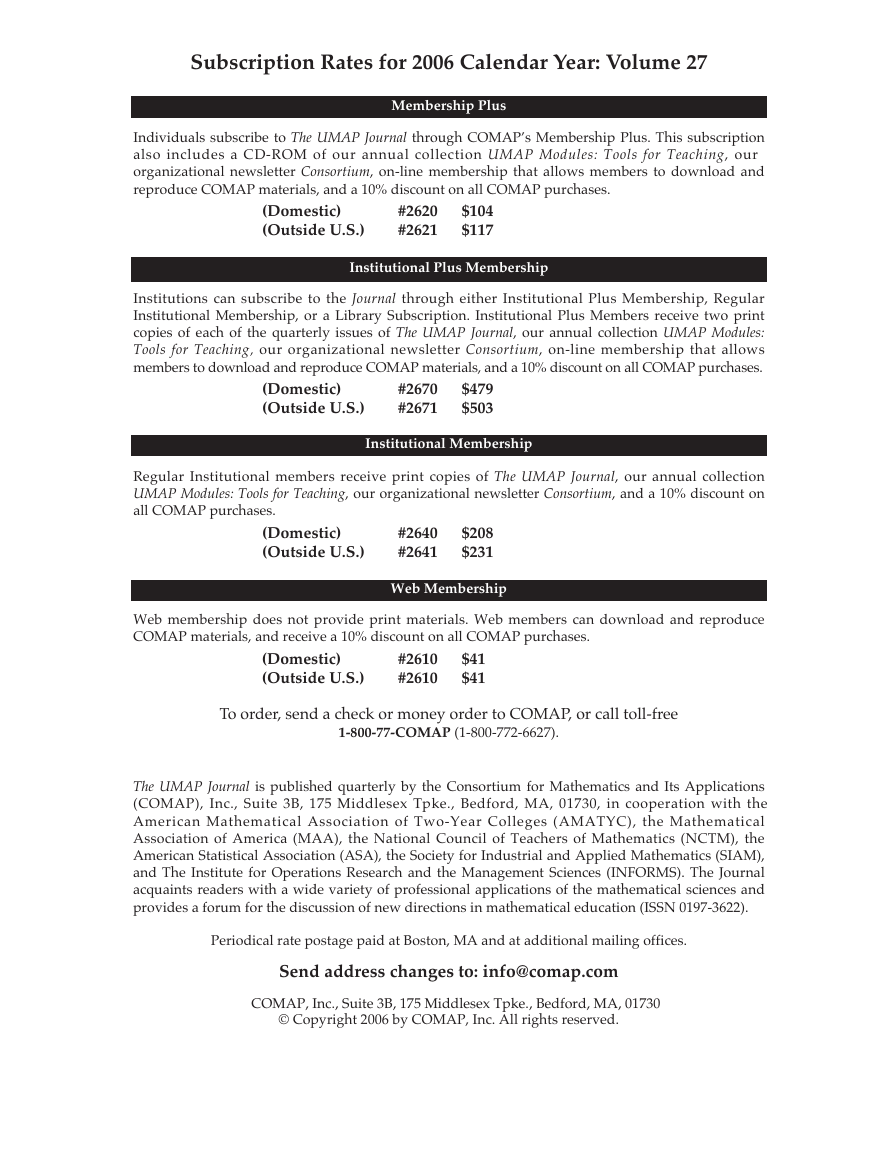
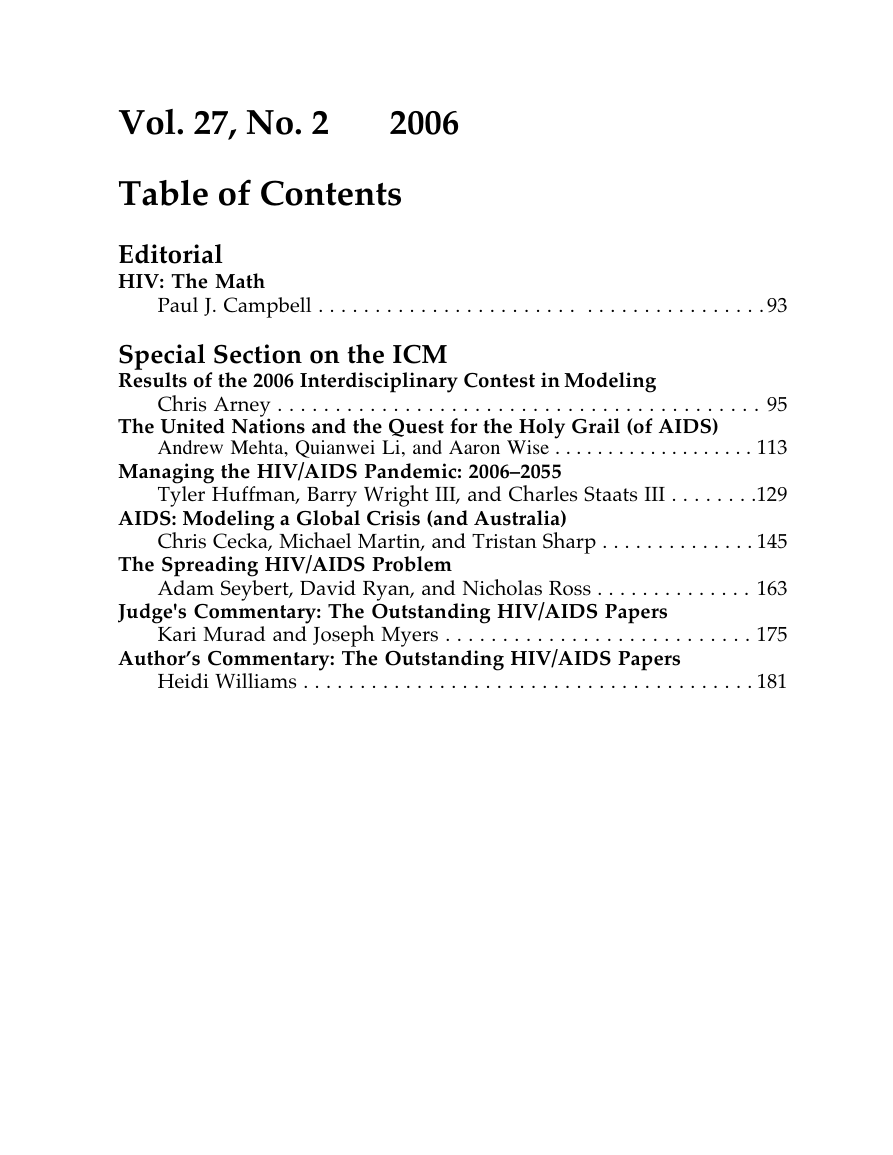

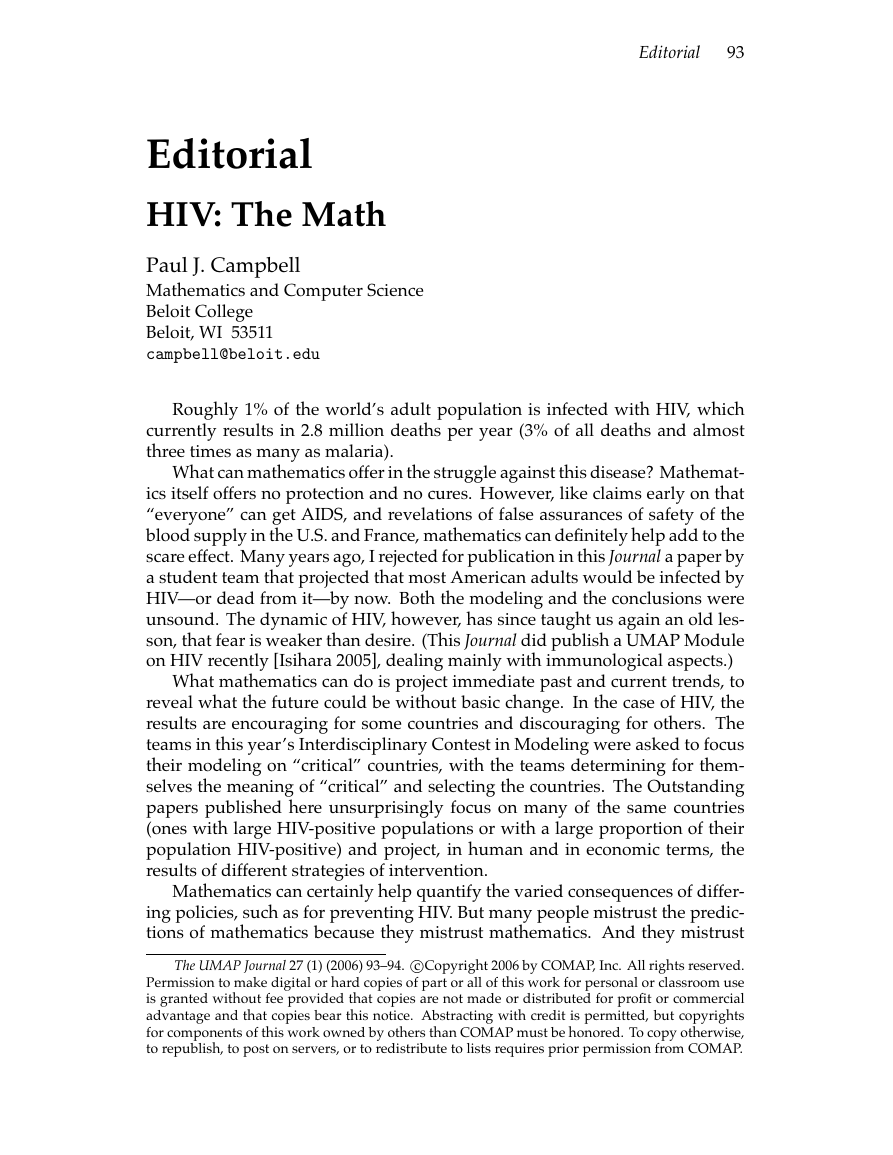

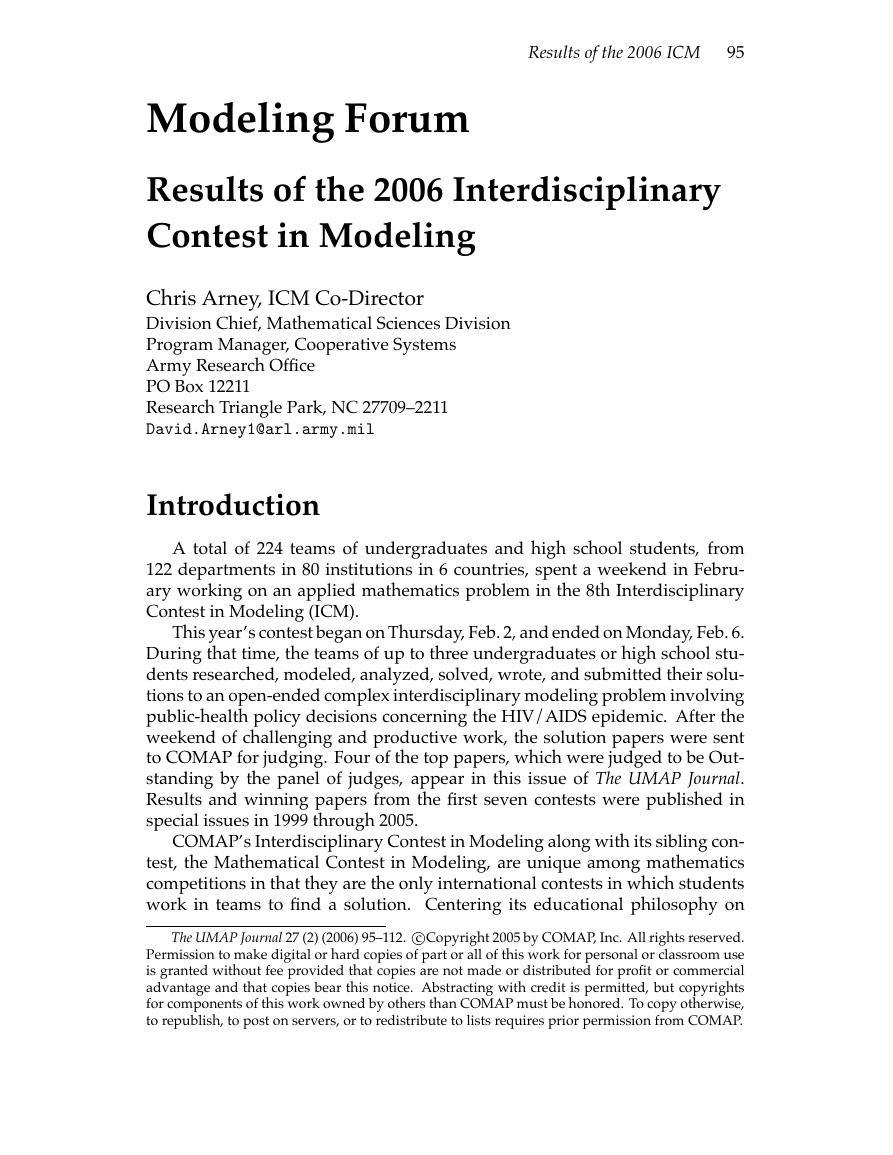
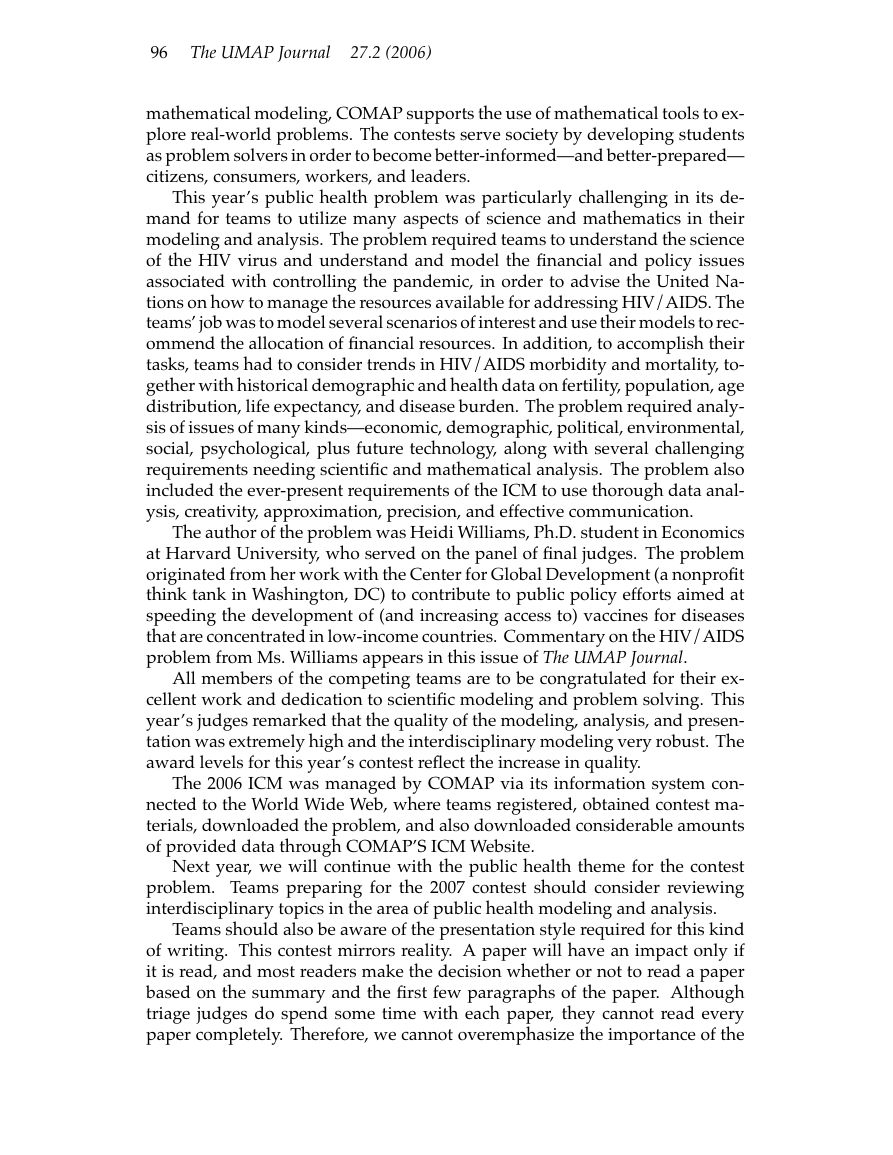








 2023年江西萍乡中考道德与法治真题及答案.doc
2023年江西萍乡中考道德与法治真题及答案.doc 2012年重庆南川中考生物真题及答案.doc
2012年重庆南川中考生物真题及答案.doc 2013年江西师范大学地理学综合及文艺理论基础考研真题.doc
2013年江西师范大学地理学综合及文艺理论基础考研真题.doc 2020年四川甘孜小升初语文真题及答案I卷.doc
2020年四川甘孜小升初语文真题及答案I卷.doc 2020年注册岩土工程师专业基础考试真题及答案.doc
2020年注册岩土工程师专业基础考试真题及答案.doc 2023-2024学年福建省厦门市九年级上学期数学月考试题及答案.doc
2023-2024学年福建省厦门市九年级上学期数学月考试题及答案.doc 2021-2022学年辽宁省沈阳市大东区九年级上学期语文期末试题及答案.doc
2021-2022学年辽宁省沈阳市大东区九年级上学期语文期末试题及答案.doc 2022-2023学年北京东城区初三第一学期物理期末试卷及答案.doc
2022-2023学年北京东城区初三第一学期物理期末试卷及答案.doc 2018上半年江西教师资格初中地理学科知识与教学能力真题及答案.doc
2018上半年江西教师资格初中地理学科知识与教学能力真题及答案.doc 2012年河北国家公务员申论考试真题及答案-省级.doc
2012年河北国家公务员申论考试真题及答案-省级.doc 2020-2021学年江苏省扬州市江都区邵樊片九年级上学期数学第一次质量检测试题及答案.doc
2020-2021学年江苏省扬州市江都区邵樊片九年级上学期数学第一次质量检测试题及答案.doc 2022下半年黑龙江教师资格证中学综合素质真题及答案.doc
2022下半年黑龙江教师资格证中学综合素质真题及答案.doc